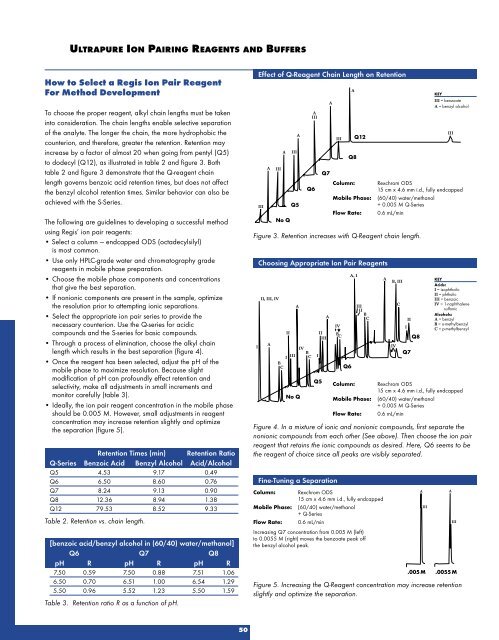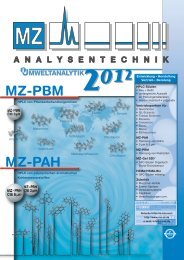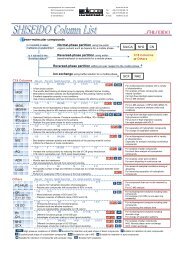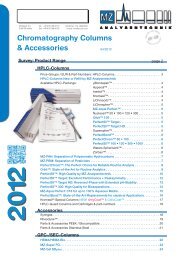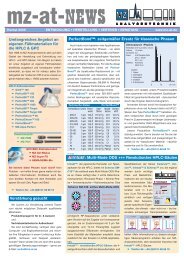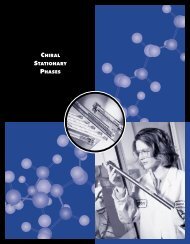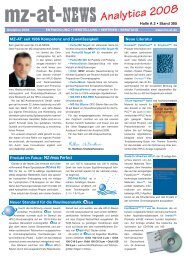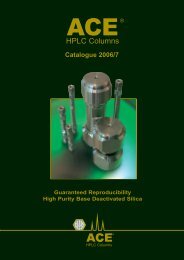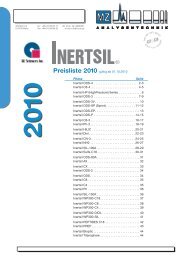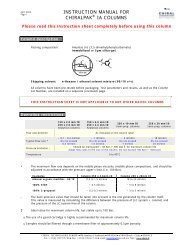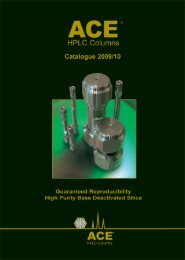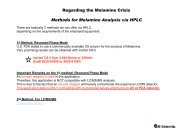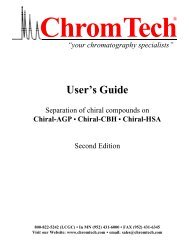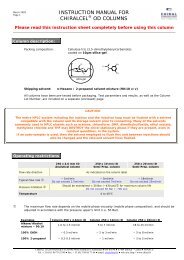You also want an ePaper? Increase the reach of your titles
YUMPU automatically turns print PDFs into web optimized ePapers that Google loves.
ULTRAPURE ION PAIRING REAGENTS AND BUFFERS<br />
How to Select a Regis Ion Pair Reagent<br />
For Method Development<br />
To choose the proper reagent, alkyl chain lengths must be taken<br />
into consideration. The chain lengths enable selective separation<br />
of the analyte. The longer the chain, the more hydrophobic the<br />
counterion, and therefore, greater the retention. Retention may<br />
increase by a factor of almost 20 when going from pentyl (Q5)<br />
to dodecyl (Q12), as illustrated in table 2 and figure 3. Both<br />
table 2 and figure 3 demonstrate that the Q-reagent chain<br />
length governs benzoic acid retention times, but does not affect<br />
the benzyl alcohol retention times. Similar behavior can also be<br />
achieved with the S-Series.<br />
The following are guidelines to developing a successful method<br />
using Regis’ ion pair reagents:<br />
• Select a column — endcapped ODS (octadecylsilyl)<br />
is most common.<br />
• Use only <strong>HPLC</strong>-grade water and chromatography grade<br />
reagents in mobile phase preparation.<br />
• Choose the mobile phase components and concentrations<br />
that give the best separation.<br />
• If nonionic components are present in the sample, optimize<br />
the resolution prior to attempting ionic separations.<br />
• Select the appropriate ion pair series to provide the<br />
necessary counterion. Use the Q-series for acidic<br />
compounds and the S-series for basic compounds.<br />
• Through a process of elimination, choose the alkyl chain<br />
length which results in the best separation (figure 4).<br />
• Once the reagent has been selected, adjust the pH of the<br />
mobile phase to maximize resolution. Because slight<br />
modification of pH can profoundly effect retention and<br />
selectivity, make all adjustments in small increments and<br />
monitor carefully (table 3).<br />
• Ideally, the ion pair reagent concentration in the mobile phase<br />
should be 0.005 M. However, small adjustments in reagent<br />
concentration may increase retention slightly and optimize<br />
the separation (figure 5).<br />
Retention Times (min) Retention Ratio<br />
Q-Series Benzoic Acid Benzyl Alcohol Acid/Alcohol<br />
Q5 4.53 9.17 0.49<br />
Q6 6.50 8.60 0.76<br />
Q7 8.24 9.13 0.90<br />
Q8 12.36 8.94 1.38<br />
Q12 79.53 8.52 9.33<br />
Table 2. Retention vs. chain length.<br />
[benzoic acid/benzyl alcohol in (60/40) water/methanol]<br />
Q6 Q7 Q8<br />
pH R pH R pH R<br />
7.50 0.59 7.50 0.88 7.51 1.06<br />
6.50 0.70 6.51 1.00 6.54 1.29<br />
5.50 0.96 5.52 1.23 5.50 1.59<br />
Table 3. Retention ratio R as a function of pH.<br />
50<br />
I<br />
Effect of Q-Reagent Chain Length on Retention<br />
III<br />
A<br />
Choosing Appropriate Ion Pair Reagents<br />
II, III, IV<br />
A<br />
III<br />
A<br />
No Q<br />
II<br />
III<br />
A<br />
Q5<br />
A<br />
IV<br />
B<br />
I<br />
III C<br />
B<br />
C<br />
No Q<br />
A<br />
III<br />
Q6<br />
II<br />
III<br />
Fine-Tuning a Separation<br />
I<br />
Q5<br />
Q7<br />
A<br />
A<br />
III<br />
IV<br />
B<br />
C<br />
Q6<br />
A<br />
Q8<br />
A, I<br />
Q12<br />
Column: Rexchrom ODS<br />
15 cm x 4.6 mm i.d., fully endcapped<br />
Mobile Phase: (60/40) water/methanol<br />
+ 0.005 M Q-Series<br />
Flow Rate: 0.6 mL/min<br />
Figure 3. Retention increases with Q-Reagent chain length.<br />
III<br />
II<br />
B<br />
C<br />
Figure 4. In a mixture of ionic and nonionic compounds, first separate the<br />
nonionic compounds from each other (See above). Then choose the ion pair<br />
reagent that retains the ionic compounds as desired. Here, Q6 seems to be<br />
the reagent of choice since all peaks are visibly separated.<br />
Column: Rexchrom ODS<br />
15 cm x 4.6 mm i.d., fully endcapped<br />
Mobile Phase: (60/40) water/methanol<br />
+ Q-Series<br />
Flow Rate: 0.6 mL/min<br />
Increasing Q7 concentration from 0.005 M (left)<br />
to 0.0055 M (right) moves the benzoate peak off<br />
the benzyl alcohol peak.<br />
Figure 5. Increasing the Q-Reagent concentration may increase retention<br />
slightly and optimize the separation.<br />
A<br />
B, III<br />
IV<br />
C<br />
I<br />
II<br />
Q7<br />
Q8<br />
Column: Rexchrom ODS<br />
15 cm x 4.6 mm i.d., fully endcapped<br />
Mobile Phase: (60/40) water/methanol<br />
+ 0.005 M Q-Series<br />
Flow Rate: 0.6 mL/min<br />
A A<br />
III<br />
KEY<br />
III = benzoate<br />
A = benzyl alcohol<br />
III<br />
KEY<br />
Acids:<br />
I = isophthalic<br />
II = phthalic<br />
III = benzoic<br />
IV = 1-naphthalene<br />
sulfonic<br />
Alcohols:<br />
A = benzyl<br />
B = o-methylbenzyl<br />
C = p-methylbenzyl<br />
III<br />
.005M .0055M


